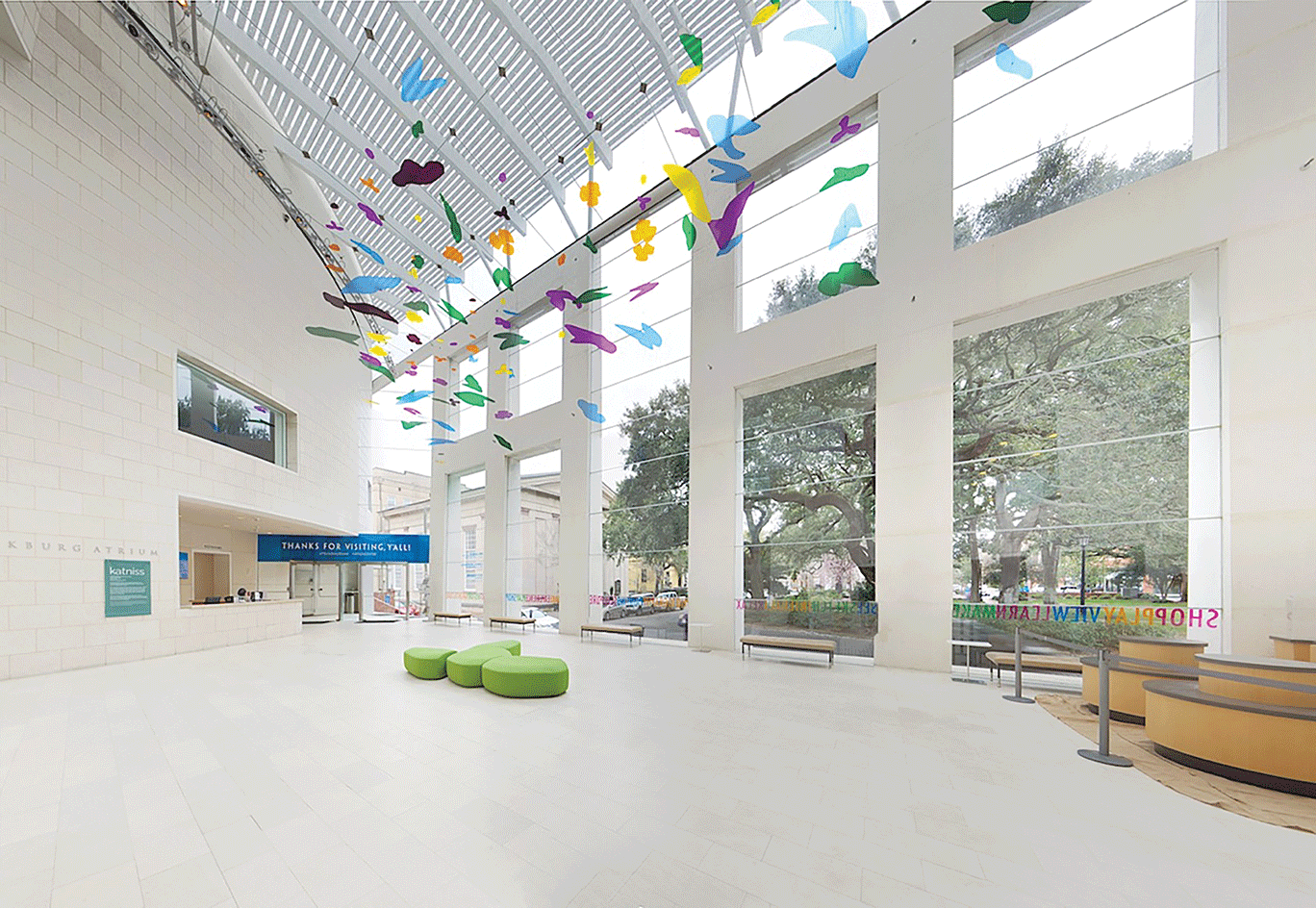« Reviews
Katherine Sandoz: Katniss
Telfair Museums/Jepson Center for the Arts - Savannah
By Robert Claiborne Morris
For this museum’s suspended sculpture, Savannah-based artist Katherine Sandoz found her subject four years ago in Pinpoint, Georgia. She was attending an early summer cookout in the small Southern town (which happens to come by its name honestly), when she noticed a katniss plant blossoming in a ditch. The aquatic plant, native to the land and a source of food and beauty for animals and humans alike for centuries, set off a chain reaction, of sorts. If something so beautiful could also be something so necessary for survival, how could it be that the katniss could also be so overlooked and underappreciated?
When Rachel Reese, curator of modern and contemporary art at the Telfair Museums asked Sandoz if she might be willing to reinvent one of her paintings for the massive Jepson Center for the Arts glass atrium rooted in the heart of Savannah’s Historic District, that flower in the ditch immediately came to Sandoz’s mind.

Katherine Sandoz, katniss, 2018/2019, variable sizes, acrylic sheeting and wire. Photo: David J. Kaminsky.
Since the early 2000s, Sandoz has employed her art to capture landscapes, or, in her words, “worked in abstraction inspired by many kinds of vistas.” Throughout her many shows and exhibitions, the theme of connecting viewers to “the practice of looking” has been central to her work. She has channeled her vision or reinvention of the natural world from Lake Tahoe, Nevada to Lacoste, France and back again to her studio in Vernonburg, a small river community of fewer than 150 people nestled just outside the Savannah city limits. Her studio, comprised of two barns on the edge of a large field, is surrounded by naturally occurring flora, fauna and blooming botanicals that she daily incorporates into her field of vision.
Her challenge was nothing short of daunting-transform 3,500 square feet of concrete, marble, steel and glass into a series of layers of leaves and flowers-a Sandoz painting. Upon entering the towering, three-story glass atrium, many (108 to be exact) shapes cut from acrylic sheets of plastic (shapes familiar to her paintings) hang from the ceiling’s structure and move with the flow of air and crowds of people as they pass. Like every aspect of her art, she was intentional about her selection of the number of shapes. “The number 108 is considered sacred in many disciplines,” she notes. “Some eastern religions like Hinduism, Buddhism and Jainism that are connected to yoga and dharma practices, believe the universe is at once (1), empty (0), and infinite (8).”

Katherine Sandoz, sagittaria, 2018/2019, water-based media, 19' x 15', site specific (temporary through May 30, 2019). Telfair Museums Commission.
Sandoz envisioned viewers standing on the ground floor looking up at her creation, the way insects, or “single-celled biota”, as she calls them, would regard the katniss plant in the wild. Depending upon the time of day or night, shadows from the shapes are cast upon the multiple angles of the walls designed by the world-renowned architect Moshe Safdie. The refractions create an endless array of new shapes that transform before the eye, but all look and own the DNA of the artist’s paintings where they originally inhabited. It is as if Sandoz has created a massive machine that is continuously spinning new versions of her paintings, hour after hour, day after day-a remarkable, transformative achievement rarely seen in the art world.
But for Sandoz, it all comes back to the katniss plant she saw in a ditch that day in rural Georgia. At the top of the grand, marble stairway leading to the third floor of the museum, or midway up the ditch she recreates, is “sagittaria,” a massive array of katniss flowers and leaves, in this 15 feet wide and 19 feet high site-specific temporary wall treatment.
It is not lost on Sandoz that the heroine of the The Hunger Games is also named after this edible botanical; or that the book’s Katniss received her name because, as her father told her, she would never go hungry if she could “find herself”. As the artist was creating the water-based painting earlier this year, she illuminated visiting young students with this idea as they stopped to ask questions.
With these two works, Sandoz encourages questioning. She challenges the viewer to “look into our own ditches,” and to follow “the practice of looking, to making the small large and exploring our world around us.”
(January 17, 2019 - Ongoing)
Robert Claiborne Morris is a multi-media artist and arts writer who lives and works on Tybee Island, Ga.
Filed Under: Reviews



































Leave a Reply
You must be logged in to post a comment.